Xiangqi (象棋): Chinese Chess
Xiangqi, known in the west as Chinese Chess, is an extremely popular game in the Eastern Hemisphere. It is currently played by millions (or tens of millions) in China, Taiwan, Thailand, Singapore, Vietnam, Hong Kong and other Asian countries. Xiangqi has remained in its present form for centuries. It is commonly believed that both Xiangqi and Orthodox Chess derive from the original Indian game of Chanturanga, but some, such as Sam Sloan and David Li, maintain that Chess is actually Chinese in origin. Whatever the relation between Xiangqi and Chaturanga, it seems highly likely that they are related, for the similarities between them are too hard to explain as just coincidences. The two games are played by approximately the same rules, and except for the Cannon, every Xiangqi piece is very similar to the Chaturanga piece that occupies roughly the same position and bears a name similar or identical in meaning.
The Mandarin pronunciation of 象棋 is something like shawn chee, and this gets romanized as Xiàng Qí
in Pinyin, as Hiangk'i
in EFEO, as HsiangCh'i
in Wade-Giles, and as SyangChi
in Yale. Its Cantonese pronunciation is jun kay, which is romanized in the jyutping system as zoeng6 kei4*2
. In the literature on the game, it has been transliterated in many other ways, including tseung k'i
(Culin), Chong-Kie
(Suzuki), Siang k‘i
(Murray), tseung-ki
(Davidson), Hsang Chi
(Gollon), and Shiang-Chi
(Sloan, "History of Chinese Chess"). While many were probably ignorant of the official romanizations, Sloan favors his spelling for being more phonetically accurate. On the web and in recent literature, the simplified Pinyin spelling of Xiangqi has become standard, and that spelling will be used here.
象 (xiàng) 棋 (qí) translates to Elephant Game. The first character is used in the game for the Elephant piece. The second means strategy game, and it also signifies one of the four arts -- qin (music), hua (brush painting), shu (calligraphy) and qí (strategy games) -- that a Chinese gentleman scholar was supposed to be proficient in. The word may have originally referred to the game now called Weiqi or Go, though in current usage it just means strategy board game.
There is much literature on Xiangqi, most of it in Chinese. There are, however, a few books available in English and other languages.
How to Play Xiangqi
If you know how to play Chess, the rules of Xiangqi will be familiar. The general idea is the same. Each player controls an army of pieces, moves one piece at a time, and tries to get the opponent's royal piece. It differs from Chess in the object, the board, the setup, the pieces, and some of the rules.
Object
The object of Xiangqi is to either checkmate or stalemate your opponent. Checkmate is the same in both games. In Xiangqi, the piece to checkmate is the opponent's General. You have checkmated your opponent when you have attacked his General (placed it in check), and he cannot eliminate the check with any move. Unlike Chess, where a stalemate counts as a draw, a stalemate in Xiangqi wins the game for the player delivering it. To avoid any confusion among Chess players who consider stalemate synonymous with draw, let me spell out the difference. Stalemate is when a player has no legal move. A draw is when a game ends in a tie. In Chess, stalemate is one condition in the game, among others, that leads to a draw. In Xiangqi, a player with no legal move loses.
Board
The traditional Xiangqi board is a grid of ten horizontal lines and nine vertical lines. The vertical lines are interrupted in the middle, so that the board appears as two grids of five horizontal lines by nine veritical lines. This interruption is called the river. It serves as a barrier to the Elephants. Other pieces can pass over it as though it's not there, Pawns gaining the ability to move sideways after crossing it. The board appears very similar to other uncheckered boards, such as the boards Shogi and Chaturanga are played on, but instead of going in the space demarcated by the lines, pieces go on the intersections. These intersections are called points. It is believed that this type of piece placement is borrowed from WeiQi (known in the west as Go). Two palaces are positioned at opposite sides of the board. Each is distinguished by an x-shaped cross connecting its four corner points. Throughout the game, each player's General and Advisers must remain in the palace.
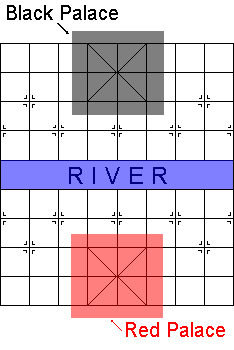
The above board shows various L-shaped markings in order to mark the setup points of Pawns and Cannons. These markings are not present on all commercial boards, and they have no bearing on the course of the game.
Setup
At the beginning of the game, pieces are placed like so. Besides the traditional board described above, a checkered board with western pieces is also shown. The rules of the game do not require the traditional board, and western players may find the game less forbidding with more familiar equipment. The checkered board used here is patterned after one that came with a commercial Chinese Chess set called Cambaluc Chinese Chess. Like the traditional board, it marks the river, the palaces, and the spaces that Cannons and Pawns begin on.
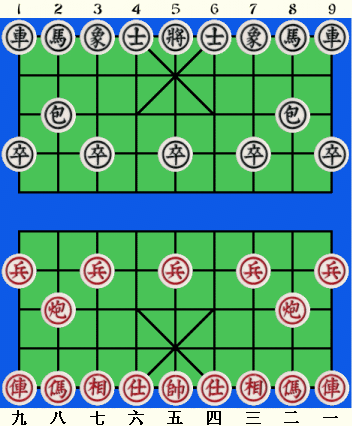
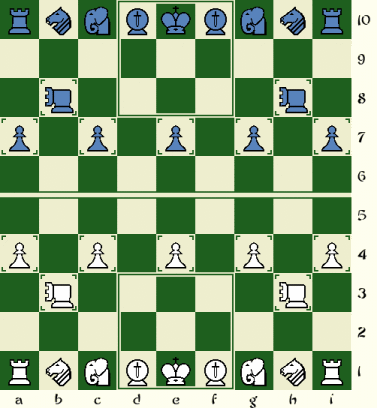
From left to right on the bottom and top rows, you see: a Chariot, a Horse, an Elephant, an Adviser, a General, an Adviser, an Elephant, a Horse, and a Chariot. On the third rows, you see the Cannons in front of the Horses, and on the fourth row you see the Pawns, one space between each Pawn. The side shown at the bottom of the board is normally called Red, the other side Black, though sometimes Blue or Green.
Pieces
Since it may be hard for westerners to remember the Chinese pieces, both Chinese and western piece images are used, and information is provided on the Chinese characters used for the pieces. Each character is linked to the page on it at chinese-characters.org, though some of the details here originally came from zhongwen.com.
Chariots / Rooks




The Chariot (or Rook) moves exactly the same as the Rook in Chess. It moves in a straight line horizontally or vertically across any number of empty spaces, stopping either on an empty space or the first space it comes to that is occupied by one of the opponent's pieces. It may not pass over occupied spaces.
The character used for the Chinese piece, 車, is the pictograph of a chariot from above, showing wheels at top and bottom.
Horses / Knights




The Horse, commonly known in Fairy Chess literature as the Mao, is capable of reaching all the same spaces that the Chess Knight can reach, but it cannot leap over pieces. When it moves, it first moves one space orthogonally followed by one more space diagonally outward. When the first space it would move over is occupied, its movement in that direction is blocked. It may never stop on the first space of its movement. So it cannot reach any space a Chess Knight could not reach.
Known as mӑ in Chinese, the character for this piece, 馬, is the pictograph of a horse, showing its head, mane, legs, and tail. The Chinese name is similar to the English word mare, which means female horse.
Minister / Elephant




The Red piece is called a Minister, the black piece an Elephant. Some literature on Chinese Chess will stick to one name or the other. H. T. Lau calls them both Ministers, while the World Xiangqi Federation calls them both Elephants. We tend to favor Elephant, as shown in the western pieces used. By whatever name, this piece moves two spaces in the same diagonal direction. Like the Horse, it may not leap over occupied spaces. So if the first step of its move is over an occupied space, it is blocked and may not make that move. Additionally, Elephants are confined to their own side of the river. Due to these limitations, the Elephant can reach only seven spaces of the board.
The two characters used for this piece are homonyms in Chinese, both transliterated as xiàng. The character for the Black piece, 象, is the pictograph of an elephant. This character is also used in the game's name. The character for the Red piece, 相, shows an eye 目 behind a tree 木. The tree is the figure on the left, and the eye is the thing that looks like a ladder. As a verb, it means to examine or study. As a noun, it means prime minister.
Advisers / Guards




The Adviser (also known as Councellor, Mandarin or Guard) moves one space diagonally. On the traditional board, the diagonal lines in the palace connect the points the Adviser may reach. It may never leave the palace. Aside from this restriction, it is identical to the Shatranj piece commonly known as a Ferz
It's Chinese name of shì means scholar. The character for the Black piece, 士, combines the characters for 1 (一) and 10 (十) to mean one who knows all from one to ten. The Red character, 仕, combines the characters for person, 人, with scholar, 士, essentially keeping the meaning the same. The names of Adviser (used by the World Xiangqi Federation) and Councellor (used by H. T. Lau) are close in meaning to this. Councellor is a common translation of both shì and ferz, but Adviser has the advantage of not beginning with the same letter as Cannon while meaning essentially the same thing. The names of Guard and Mandarin were both popularized by John Gollon. The name of Guard describes the function of the piece in the game. A Mandarin was a kind of public official in the Chinese empire. Neither seems to be an accurate translation.
General / King




The General moves one space orthogonally within the confines of the palace. The two Generals cannot face each other on an open file. For example, a red General on e1 and a black General on e10, with no piece on the e-file between them, is an illegal position. If either General sits exposed on an open file, the other General may not move to occupy that file. Unlike the King in Chess, the General may not move diagonallly.
The Black character for this piece, 將, tranliterated as jiáng, combines a character for law, 寸, in the lower right corner, with a phonetic. It means will or going to. The Red character, 帥, transliterated as shuái, combines characters for hill 𠂤 and banner 巾. The hill is on the left side, the banner on the right. As a noun, it means commander, as an adjective, handsome.
Cannons




The Cannon moves differently when it moves to capture than when it moves passively. It moves the same as the Chariot when it is not capturing a piece, and it moves in the same directions when capturing except that to make the capture it must hop over a single intervening piece, referred to as the screen. In other words, Cannons capture by hopping over a second piece in order to capture a third piece. For example, a Cannon on a1 can take a piece on f1 when exactly one of the spaces b1, c1, d1, or e1 is occupied by a piece of either color. Cannons only capture when hopping and only hop when capturing. They may never hop over more than one piece in a given move.
The character for the Red piece, 炮, shows fire on the left and the phonetic for its Chinese name of páo, 包. The character for the Black piece shown here just has the phonetic, but in some sets the Black piece is displayed as 砲, showing a stone 石 with the phonetic. The Chinese páo sounds like the English sound effect pow, and given that the character includes the phonetic for this sound, it is likely that the Chinese name for the Cannon is onomatopoeic.
Soldiers / Pawns




The Xiangqi Pawn moves one space vertically forward. Upon crossing the river, it gains the additional ability to move one space sideways. Unlike orthodox Pawns, its passive move and capture move are always the same, it never gets a double move, and it does not promote to another piece on the last rank. Being unable to move forward any longer, a Pawn on the last rank can only move left or right.
The Red piece, 兵, transliterated as bing, shows hands 廾 wielding an axe 斤. The Black piece, 卒, transliterated as zú, combines the pictograph of a cloak 衣 with the number 1 一 or a stroke mark 丿. Both characters mean soldier.
Other rules
- Red moves first.
- Perpetual check is forbidden. You cannot check your opponent more than three times in a row with the same piece and same board positions.
- You cannot force an enemy piece to move to and from the same two spaces, indefinitely, in order to avoid capture. If you move a Rook to e5, threatening a Cannon on e6, and your opponent's only viable move is Cannon to f6, then you cannot force that Cannon to and from e6 and f6 by moving your Rook to and from e5 and f5, indefinitely. The purpose of this rule (and the above rule) is to avoid perpetual-check draws. Some of these situations are complicated, but the person who is forcing the perpetual move must usually break it off.
- The game is a draw when neither side can force a checkmate or a stalemate.
Sets
Here are photos of sets, both commercial and handmade, that are owned by some of us:
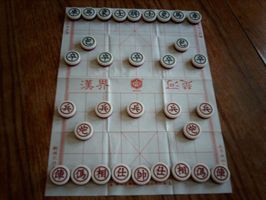
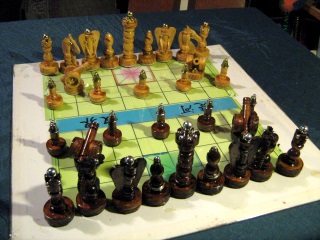
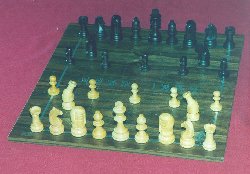
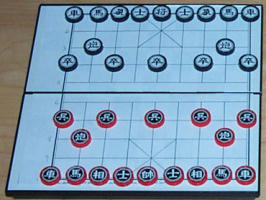
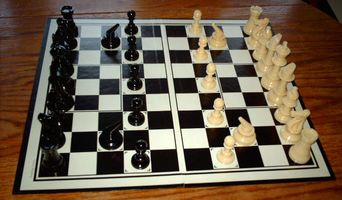
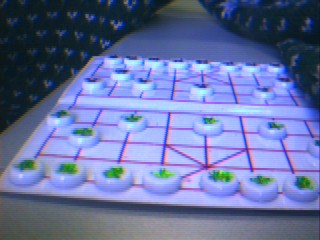
Notation
Traditional Notation
The traditional notation used by the Chinese writes a move in four parts. This consists of (1) The character for the piece. (2) The number identifying the file the piece is on. Files are numbered 1 to 9 from each player's right hand side. Chinese numerals are used for Red and Arabic numerals for Black. In the traditional diagram shown above, the Chinese numerals at the bottom of the board are 9 to 1 going left to right. If the board were flipped around to Black's perspective, then they would be going from 1 to 9, just as the Arabic numerals are currently going. When a player has two pieces of the same type on the same file and moves one, the file number is not used to designate which piece moved. Instead, the character for the piece is preceded by 前 (xìn) for front or 後 (han) for rear. (3) A direction indicator, 進 (jìn) for advancing forward, 退 (tùi) for retreating backward, or 平 (píng) for traversing horizontally. For pieces that move only along ranks and files, the choice of direction indicator is dictated by the move. For pieces that change both rank and file with a move, only the forward and backward direction indicators are used. (4) The file the piece moves to, or, for purely vertical movement, the number of ranks moved. Again, this will be in Chinese for Red and in Arabic for Black.
In his book Chinese Chess, H. T. Lau adapts this style of notation to English. Instead of Chinese characters for the pieces, he uses these English letters: K for King, S for Councellor, M for Minister, R for Rook, N for Knight, C for Cannon, and P for Pawn. He uses Arabic numerals for both sides. For the direction indicators, he uses f for forward, b for backward, and h for horizontal. When two pieces of the same type occupy the same file, he precedes its letter with f for front or r for rear.
The World Xiangqi Federation has also adapted this style of notation to English. Instead of Chinese characters for the pieces, they use these English letters: K for King, A for Adviser, E for Elephant, R for Rook, H for Horse, C for Cannon, and P for Pawn. They use Arabic numerals for both sides. For the direction indicators, they use + for forward, - for backward, and = or . for horizontal. When two pieces of the same type occupy the same file, WXF notation precedes its letter with + for the front piece or - for the rear piece. For multiple Pawns on the same file, a rare occurrence in most games, further details are described on the WXF notation page from the World Xiangqi Federation's website. WXF notation is supported by the programs Coffee Chinese Chess and Qianhong.
The Xiangqi Database uses these English letters: K for King, A for Advisor, B (as in Bishop) for Elephant/Minister, R for Rook, N for Knight, C for Cannon, and P for Pawn.
Algebraic Notation
Borrowed from Chess, algebraic notation assigns fixed designations to each rank and file, using these to assign a unique name to each location on the board. Following Chess as our model, these should be the letters a through i for the files and the numbers 1 through 10 for the ranks, as shown in the western setup diagram above. This coordinate system is used by Zillions-of-Games, by Game Courier, and by D. B. Pritchard in his book The Encyclopedia of Chess Variants. But there has not been uniform agreement on this matter. The International Chinese Chess Server (ICCS) numbers the ranks from 0 to 9, and the ICCS standard is supported by the Qianhong program. The Chinese Chess program that comes in Global Star's Ten Pro Board Games collection uses numbers for the files and letters for the ranks, perhaps taking its cue from Shogi, which is included in the same collection of programs.
The simplest type of algebraic notation, commonly used by computer programs, designates a move by two coordinates, the first indicating where the piece moved from, the second indicating where the piece moves to. ICCS, Zillions-of-Games, and Game Courier all use algebraic notation of this sort. Algebraic notation can also follow the style common for Chess of writing the move as briefly as possible. D. B. Pritchard uses notation of this sort in the Xiangqi entry of his Encyclopedia of Chess Variants. In this manner, a Pawn move is designated by just its destination, most normal moves by the piece notation and the destination, captures with an x and the notation for the piece captured, and ambiguous moves by also indicating which space the piece moves from.
Tactics
The Block
Attacks by Chariots, Horses, Elephants, and Cannons can be blocked by moving another piece into the line of attack. But doing so can allow your opponent to pin your piece.
The Pin
When a move by a piece would reveal a check on the same player's General or an attack on a more valuable piece, then it is pinned. A pinned piece is less mobile than other pieces. It may not be able to flee from an attack, and it may not be able to defend a space it could otherwise move to. Like its counterpart in Chess, the Chariot can pin pieces. Because of the rule against opposing Generals, a General can pin a piece on one of the three central files. Since Horses and Elephants step to their destination instead of leaping there as the Chess Knight does, they are also capable of pinning pieces.
The Double Pin
The double pin is a tactic of Chinese Chess that is unavailable in Chess. Since a Cannon hops over an intervening piece to capture, it takes two pieces to block a Cannon attack. If one piece moves away, the Cannon can hop over the other one to capture a piece. This allows a Cannon to pin two pieces in the same line of attack.
The Fork
A fork is an attack on two or more pieces by the same piece. Your opponent will be able to move only piece away on his next turn, leaving the other available to be captured. In some cases, it is possible to cancel both attacks of a fork with one move. For example, the piece that moves away may move to block the other attack.
The Skewer
The skewer is an attack on the General or some other valuable piece that is blocking an attack on another piece. Once the attacked piece moves away, the other piece can be captured. Note that the skewer doesn't work so effectively when your aim is to capture a Cannon, for the Cannon can hop over the allegedly skewered piece to capture your Chariot. The skewer tactic is available only to Chariots and Cannons in Xiangqi. Although Horses and Elephants can be pinned, they cannot skewer, because they cannot capture on the first step of their move.
Xiangqi Variants
Xiangqi has inspired many variants. Some look a lot like Xiangqi, and some combine elements of Chess and Xiangqi. Here are some that are primarily based on Xiangqi but look different:
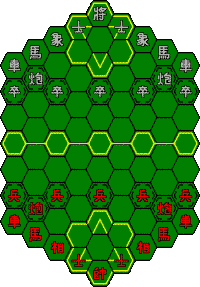
Xiang Hex - A hexagonal version of Xiangqi
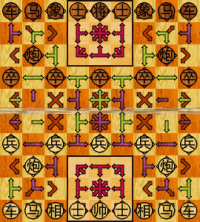
Storm the Ivory Tower - A Smess adaptation of Xiangqi
Bibliography
- Culin, Stewart
- Korean Games With Notes on the Corresponding Games of China, 1895.
- Davidson, Henry A.
- A Short History of Chess,
- Falkener, Edward
- Games ancient and oriental and how to play them, being the games of the ancient Egyptians, the Hiera Gramme of the Greeks, the Ludus Latrunculorum of the Romans and the oriental games of chess, draughts, backgammon and magic squares, 1892.
- Forbes, Duncan
- The History Of Chess : From The Time Of The Early Invention Of The Game In India, Till The Period Of Its Establishment In Western And Central Europe, 1860.
- Gollon, John
- Chess Variations, 1968
- Lau, H. T.
- Chinese Chess: An Introduction to China's Ancient Game of Strategy
- Murray, H. J. R.
- The History of Chess
- A Short History of Chess
- Pritchard, David
- Encyclopedia of Chess Variants, 2001
- Popular Chess Variants, 2003
- Sloan, Sam
- "History of Chinese Chess" in the Ishi Press printing of Gollon's Short History.
- Suzuki, Choyo
- Japanese chess (shogi); the science and art of war or struggle philosophically treated. Chinese chess (chong-kie) and i-go, 1905
- Originally written by Hans Bodlaender. Largely rewritten by Fergus Duniho.
- Certain parts of the text were taken from Steven Leary's FAQ for Chinese Chess.
- Thanks also to Ivan A Derzhanski for corrections to the linguistic information on the word Xiangqi.
- Thanks to John William Brown for editing this page in response to Xiangqi being selected as Recognized Variant of the Month.
- Thanks to Robert Price for pointing out an error in the King's movement description.
- Graphics updated by Fergus Duniho. Traditional pieces scanned from actual pieces. Alfaerie pieces used for westernized pieces. Chess pieces made by David Howe from the Chess Alpha font by Eric Bentzen. Guard images by Michael Howe. Remaining Alfaerie pieces by David Howe.
Credits
WWW page created: July 1, 1996. Last modified: Oct 8, 2001.
